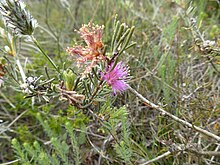| Melaleuca holosericea | |
|---|---|

| |
| Scientific classification | |
| Kingdom: | Plantae |
| Clade: | Tracheophytes |
| Clade: | Angiosperms |
| Clade: | Eudicots |
| Clade: | Rosids |
| Order: | Myrtales |
| Family: | Myrtaceae |
| Genus: | Melaleuca |
| Species: | M. holosericea |
| Binomial name | |
| Melaleuca holosericea Schauer | |
| Synonyms | |
|
Myrtoleucodendron holosericeum (Schauer) Kuntze | |
Melaleuca holosericea is a plant in the myrtle family Myrtaceae which is endemic to the south-west of Western Australia. It is a small, rare shrub similar to other pink-flowered species in the Melaleuca scabra group.
Description
Melaleuca holosericea grows to about 0.6 m (2 ft) high, rarely taller. The leaves and branches are often covered with a dense covering of soft, silky hairs. The leaves are 6–13 mm (0.2–0.5 in) long and 0.5–1 mm (0.02–0.04 in) wide, linear in shape, almost circular in cross section and tapering at the end.
The pinkish flowers are arranged in heads up to 16 mm (0.6 in) diameter at the ends of branches which continue to grow after flowering, each head containing between two and five groups of flowers in threes. The petals are 1.5–3 mm (0.06–0.1 in) long and fall off as the flower opens. The stamens are arranged in five bundles around the flower, each bundle containing between 7 and 9 stamens. The main flowering period is in early spring and is followed by the fruit which are woody capsules about 3–4.5 mm (0.1–0.2 in) long.


Taxonomy
Melaleuca holosericea was first formally described in 1844 by Johannes Conrad Schauer in Plantae Preissianae. The specific epithet (holosericea) is from Ancient Greek, meaning "entire, complete or whole" and "silk", referring to the silky hairs on the branches and leaves.
Distribution and habitat
This melaleuca occurs in the Clackline, Toodyay and Northam districts in the Avon Wheatbelt and Jarrah Forest biogeographic regions. It grows in sandy and gravelly soils on undulating plains and ridges.
Ecology
Melaleuca holosericea has been found to be resistant to Phytophthora cinnamomi
Conservation status
Melaleuca holosericea is listed as "not threatened" by the Government of Western Australia Department of Parks and Wildlife.
References
- ^ "Melaleuca holosericea". Plants of the World Online. Retrieved 30 August 2021.
- ^ Brophy, Joseph J.; Craven, Lyndley A.; Doran, John C. (2013). Melaleucas : their botany, essential oils and uses (PDF). Canberra: Australian Centre for International Agricultural Research. p. 191. ISBN 9781922137517. Retrieved 4 April 2015.
- ^ Holliday, Ivan (2004). Melaleucas : a field and garden guide (2nd ed.). Frenchs Forest, N.S.W.: Reed New Holland Publishers. p. 250. ISBN 1876334983.
- "Melaleuca holosericea". APNI. Retrieved 23 July 2015.
- Lehmann, J.G.C., ed. (1844). Plantae Preissianae. pp. 139–140. Retrieved 4 April 2015.
- ^ "Melaleuca holosericea". FloraBase. Western Australian Government Department of Biodiversity, Conservation and Attractions.
- Paczkowska, Grazyna; Chapman, Alex R. (2000). The Western Australian flora : a descriptive catalogue. Perth: Wildflower Society of Western Australia. p. 394. ISBN 0646402439.
- "Western Australian natives resistant to Phytophthora cinnamomi" (PDF). Centre for Phytophthora science & management (CPSM). Retrieved 4 April 2015.
| Taxon identifiers | |
|---|---|
| Melaleuca holosericea | |